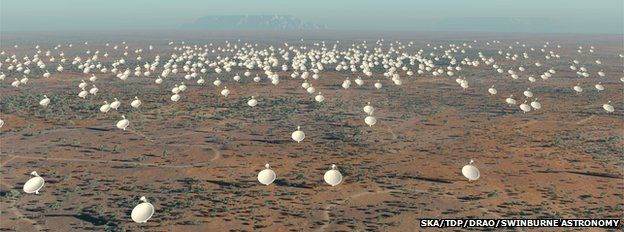Africa and Australasia to share Square Kilometre Array
-
Published

South Africa, Australia and New Zealand will host the biggest radio telescope ever built.
The nations belonging to the Square Kilometre Array (SKA) organisation took the decision at a meeting on Friday.
The 1.5bn-euro (£1.2bn) SKA's huge fields of antennas will sweep the sky for answers to the major outstanding questions in astronomy.
They will probe the early Universe, test Einstein's theory of gravity and even search for alien intelligent life.
The project aims to produce a radio telescope with a combined collecting area of one million square metres - equivalent to about 200 football pitches.
To do this, it will have to combine the signals received by thousands of small antennas spread over thousands of kilometres.
Sharing the wealth
South Africa and Australasia had put forward separate, competing bids, and the early indications had been that there would be one outright winner.
But the SKA organisation decided both proposals should contribute something to the final design of the telescope.
"We have decided on a dual site approach," said SKA board chairman Prof John Womersley.
He was speaking at a news conference held at Amsterdam's Schiphol Airport following a meeting of the organisation's members in the Dutch capital.
The decision to use two sites will undoubtedly increase the cost and complexity of the SKA.
Its targets will be radio sources in the sky that radiate at centimetre to metre wavelengths.
These include the clouds of hydrogen gas in the infant Universe that collapsed to form the very first stars and galaxies.
The SKA will map precisely the positions of the nearest billion galaxies. The structure they trace on the cosmos should reveal new details about "dark energy", the mysterious negative pressure that appears to be pushing the Universe apart at an ever-increasing speed.
The telescope will also detail the influence of magnetic fields on the development of stars and galaxies. And it will zoom in on pulsars, the dead stars that emit beams of radio waves that sweep across the Earth like super-accurate time signals.
Astronomers believe these dense objects may hold the key to a more complete theory of gravity than that proposed by Einstein.
Different strengths
The Australasian bid was centred on a site at Boolardy Station, about 500km (310 miles) north of Perth in Western Australia. For South Africa, the central location put forward was in the Karoo in the Northern Cape, about 95km from Carnarvon.
Both have exceptional conditions for radio astronomy in that, being remote territories, they experience very little stray interference from cellular phone networks and TV broadcasts.
Pallab Ghosh visits Jodrell Bank where the SKA project team is based
And Australia and South Africa had even started building precursor facilities which they hoped would enhance their bids' attractiveness.
Both these pathfinders, known as ASKAP (Australia) and Meerkat (South Africa), will now be incorporated into the early development of the network.
Most of the subsequent telescope dishes and mid-frequency aperture arrays will then be built in southern Africa (sites will include Namibia, Botswana, Mozambique, Kenya, Zambia, and even out into the Indian Ocean in Mauritius and Madagascar) - the bulk of the SKA.
The low-frequency aperture array antennas will be positioned in Australia.
Prof Bryan Gaensler, from Sydney University and a former project scientist on the SKA, commented: "What the SKA project has decided is to put different technologies in different places, playing to the strengths of each site."
And Prof Womersley told BBC News: "The important aspect of doing it this way is that we will get more science out of the project in the first phase by taking advantage of the existing ASKAP and Meerkat investments. So, while there'll be some additional operating costs associated with this implementation, we will get more science in return."
Dr Bernie Fanaroff, the SKA South Africa project director, expressed his delight at the news.
"I think it's wonderful," he said.
"It means that for the first time in our history, Africa will be the host to the world's largest scientific instrument. And it shows a great deal of faith by the rest of the world in our ability and our capacity to both build and operate such a sophisticated instrument. It also reflects the recognition in Africa of how important science and technology is to our future."
Long game
The SKA's members include the UK, Netherlands, Italy, China, Canada, Australia, New Zealand and South Africa. India has associate member status.
There will be major industrial return for all members. The next project engineering phase is worth about 90m euros.
Phase 1 of the project, due to start in 2015/16, was valued at around 360m euros. The cost of the last phase was always uncertain and depended on knowing exactly where the SKA would be built and the final design it would take; but a sum of 1.5bn euros was considered a likely figure.
"This a long programme," said Dr Fanaroff.
"The construction phase alone will last from about 2013 to 2025. So, there's direct spin-off from construction, and there's the creation of employment through operations and maintenance that will go on for about 50 years.
"But there's also the less tangible - but more important in my view - economic aspect, which is the development of our capabilities in very hi-tech sectors, and the ability of our universities to attract large numbers of the best young people into science and engineering," he told BBC News.
Jonathan.Amos-INTERNET@bbc.co.uk and follow me on Twitter
-
-
Published19 April 2012
-
-
-
Published10 March 2012
-
-
-
Published2 April 2011
-
-
-
Published31 March 2011
-